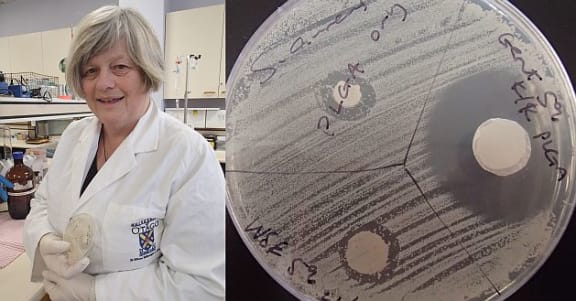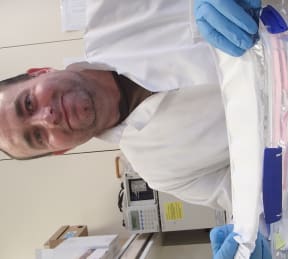
Microbiologist Michelle McConnell holds an agar plate testing the well-known anti-bacterial effects of the common antibiotic gentomicin (the large clear area), compared to the effect produced by wine waste (the smaller circles) Photo: RNZ / Alison Ballance
A University of Otago meat scientist’s interest in using waste products, such as the grapes and seeds left over from wine-making, has led to a fruitful collaboration with a pharmacist and a microbiologist that they hope will lead to a new generation of naturally-based medical dressings and meat wraps.
“I’m interested in the utilisation of waste material, and one of the things I’m really interested in is waste from wine making,” says Alaa El-Din Bekhit. “We became interested in very wonderful biochemical compounds called polyphenols, and they’ve been attributed to good benefits for the food industry as well as to health in general.”
Microbiologist Michelle McConnell says that “we’ve been looking to see if [these compounds that are in the grape skins are] active against a number of bacteria, as well as the virus that causes cold sores. We’re just, at this stage, playing around with the amounts of wine waste that we can incorporate into these [nano] fibres.”

Pharmacist Greg Walker holds experimental nano-fibre wound dressings, that have been created using electro-spinning and contain polyphenols produced from wine waste. Photo: RNZ / Alison Ballance
Pharmacist Greg Walker has been working using nano-fibres produced by electrospinning. He envisions a nano-fibre wound dressing that has bio-actives such as polyphenols woven into the fabric of the dressing, and he is particularly interested in fabricating a controlled slow-release dressing.
“My role is delivering these bioactives to the body,” says Greg. “It’s all very well that we can show it works in a test tube, but we need to get it in a form that can be delivered to the body.”
Meanwhile Alaa, whose work in using waste products initiated the project, told Alison Ballance that he is hopeful that nano-fibre fabric with in-built anti-microbial properties might be of direct benefit to his own meat research, perhaps in the creation of a meat wrap that could extend meat’s shelf life.
Greg stresses that it’s still early days for the project, but he sees benefits in going down the “natural route.”
Electrospinning has featured in a previous Our Changing World story looking at uses for collagen from waste hoki skin.

Food scientist Alaa El-Din Bekhit and summer students Avis Kao and Lei Xia, with the electro-spinning machine that incorporates polyphenols with natural polymers to create textiles Photo: RNZ / Alison Ballance
From Wine Waste to Wound Dressing Audio

